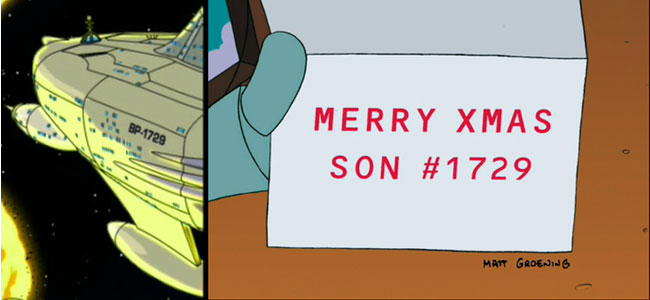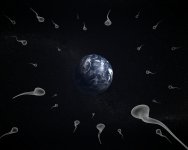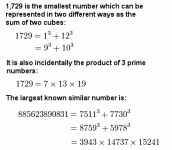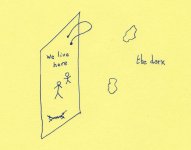Oh Lor, that multiplication thing is a nightmare!
I didn't understand any of the papers. It's not that simple method in the Quanta article.
To multiply two numbers, you write them as polynomials and multiply them in some way into a bigger polynomial.
So, say, famous Heegner Number 163 is written as x^2 + 6x + 3 and do the maths. x will be 10 here, you follow? But it's more complicated than that when you convert to a fast fourier transform.
But apparently it shows its benefits at numbers of an extremely familiar size:
Multiplication Hits the Speed Limit | January 2020 | Communications of the ACM
So the answer to Life, The Universe and Everything is 1729!
I love being right. 😀
I didn't understand any of the papers. It's not that simple method in the Quanta article.
To multiply two numbers, you write them as polynomials and multiply them in some way into a bigger polynomial.
So, say, famous Heegner Number 163 is written as x^2 + 6x + 3 and do the maths. x will be 10 here, you follow? But it's more complicated than that when you convert to a fast fourier transform.
But apparently it shows its benefits at numbers of an extremely familiar size:
The n(logn) bound means Harvey and van der Hoeven's algorithm is faster than Schönhage and Strassen's algorithm, or Fürer's algorithm, or any other known multiplication algorithm, provided n is sufficiently large. For now, "sufficiently large" means almost unfathomably large: Harvey and van der Hoeven's algorithm doesn't even kick in until the number of bits in the two numbers being multiplied is greater than 2 raised to the 1729^12 power. (By comparison, the number of particles in the observable Universe is commonly put at about 2^270.)
Harvey and van der Hoeven made no efforts to optimize their algorithm. This was partly because they were focused on the theoretical advance, and partly because they were tickled when their back-of-the-envelope calculations led them to the number 1729, which, in a famous anecdote, the mathematician Srinivasa Ramanujan called a "very interesting" number (because it is the smallest number that can be written as a sum of two cubes in two different ways). "When I saw this, I burst out laughing," Harvey recalled.
Multiplication Hits the Speed Limit | January 2020 | Communications of the ACM
So the answer to Life, The Universe and Everything is 1729!
I love being right. 😀
Last edited:
Coincidently, the Comet of 1729 was discovered by professor of mathematics, Father Nicolas Sarrabat. This was a most unusual comet, potentially the largest ever seen, but unfortunately not a spectacular object in the night sky.So the answer to Life, The Universe and Everything is 1729!
CometBase. C/1729 P1 (Sarabat) - unlucky comet of the millennium
It is unknown if this comet will return in a hundred thousand years or be ejected out of the Solar System.
The Comet of 1729 is also known as Sarabat's Comet. The misspelling of it's discoverer's name was down to Cassini who wrote the official designation.
Attachments
I wouldn't read too much into years. Fairly arbitrary.
Ramanujan was one of the most significant mathematicians of recent times. IMO.
Hardy immediately recognised his ability. The j-invariant (1728) was particularly Ramanujan. He was tryng to solve Fermat. Missed by one.
j-invariant - Wikipedia
Everything I love in Maths. The Monster Group. Fermat's Last theorem. The taxicab number (1729). The Riemann hypothesis.
Ah well. Keeps me entertained. 😀
Ramanujan was one of the most significant mathematicians of recent times. IMO.
Hardy immediately recognised his ability. The j-invariant (1728) was particularly Ramanujan. He was tryng to solve Fermat. Missed by one.
j-invariant - Wikipedia
Everything I love in Maths. The Monster Group. Fermat's Last theorem. The taxicab number (1729). The Riemann hypothesis.
Ah well. Keeps me entertained. 😀
I wouldn't read too much into years. Fairly arbitrary.
That definition is a good description of how this thread progresses.Arbitrary: Based on random choice or personal whim, rather than any reason or system.
I don't think the thread exists for any higher purpose, mathematical or otherwise! 😉
Do you know why the number 1729 is hidden in Futurama episodes?

Why is the number 1,729 hidden in Futurama episodes? - BBC News
Attachments
Anyway, boys, we have some super-ancient rocks to entertain us. 😀
Asteroid capsule located in Australian desert - BBC News
What does it mean? No idea. 🙂
Asteroid capsule located in Australian desert - BBC News
What does it mean? No idea. 🙂
That is a click bait.
Nothing but the planned recovery in an australian desert near Adelaide.
Nothing but the planned recovery in an australian desert near Adelaide.
Did you know that in excess of 16 metric tonnes of space rock fall to Earth every year?
Antarctic meteorites yield global bombardment rate - BBC News
The best place to find meteorites is Antarctica.
Antarctic meteorites yield global bombardment rate - BBC News
The best place to find meteorites is Antarctica.
Attachments
Phys. Rev. D 83, 086004 (2011) - De Sitter brane-world, localization of gravity, and the cosmological constant
Above my pay grade but this seems on topic chaps.
Above my pay grade but this seems on topic chaps.
MartyMG, You test me greatly:
Brane-World Gravity | SpringerLink
Ed Witten's M-Theory is as mad as box of frogs, IMO. I have a vague idea about Conformal Field Theory, the LHIC fireball and the AdS/CFT correspondence:
AdS/CFT correspondence - Wikipedia
Thing is. Going too deeply into the abstract can drive you nuts. Anecdotally, Einstein couldn't even remember where he lived. 😱
Brane-World Gravity | SpringerLink
Ed Witten's M-Theory is as mad as box of frogs, IMO. I have a vague idea about Conformal Field Theory, the LHIC fireball and the AdS/CFT correspondence:
AdS/CFT correspondence - Wikipedia
Thing is. Going too deeply into the abstract can drive you nuts. Anecdotally, Einstein couldn't even remember where he lived. 😱
Attachments
I too am big fan of Leonard Susskind's Stanford lectures on YouTube. The ER = EPR conjecture suggesting that our space-time is emergent from entanglement is especially interesting given the limitations of my intellect and education. All the brane world anti desitter stuff with our universe being a 3d + brane sitting in higher dimensions and gravity leaking into the bulk are best contemplated after some lovely wine! All the best chaps, I'll go back to lurking now.
No MartyMG, that is an interesting article. Just that I am very wary of M-Theory. And I sat through Susskind's Stanford lectures too. More standard Model myself.
FWIW, it was the RHIC Fireball with adS/CFT. A typo by me.
Relativistic Heavy Ion Collider - Wikipedia
It does seem that we need 4 spatial dimensions to explain what we are seeing. But commonsense says we have 3. I just don't know if I want to go there.
It's like the old flat Earth map of the World. When you reached the edge, the map advised you that beyond here be Dragons. 😱
FWIW, it was the RHIC Fireball with adS/CFT. A typo by me.
Relativistic Heavy Ion Collider - Wikipedia
It does seem that we need 4 spatial dimensions to explain what we are seeing. But commonsense says we have 3. I just don't know if I want to go there.
It's like the old flat Earth map of the World. When you reached the edge, the map advised you that beyond here be Dragons. 😱
Last edited:
I didn't understand a word of that oldish article on M-Theory. No idea what a "brane" is, 😕
I found some newer stuff that at least hints how quantum gravity might work.
What Is Quantum Gravity? | Space
And a bit of AdS/CFT hologram stuff to follow:
Are We Living in a Hologram? | Space
It's interesting that the surface area of a Black Hole grows by one planck area for every bit of information it absorbs. Which is where the hologram idea comes in. It's like the information is on the surface, not in the volume.
I used to make Ruby Laser holograms on photographic glass plates in the Physics Lab. Got quite good at them. It's a sort of 3D photography. You find them on credit cards and software cartons these days.
I found some newer stuff that at least hints how quantum gravity might work.
What Is Quantum Gravity? | Space
And a bit of AdS/CFT hologram stuff to follow:
Are We Living in a Hologram? | Space
It's interesting that the surface area of a Black Hole grows by one planck area for every bit of information it absorbs. Which is where the hologram idea comes in. It's like the information is on the surface, not in the volume.
I used to make Ruby Laser holograms on photographic glass plates in the Physics Lab. Got quite good at them. It's a sort of 3D photography. You find them on credit cards and software cartons these days.
Last edited:
It's not that Albert forgot where he lived, it's that he, like every one else, had occasional adestinesia. Which takes two forms- "why did I come to the kitchen",
and "was I going to the kitchen or the dining room?"
and "was I going to the kitchen or the dining room?"
My 'brane' hurts just thinking about it!No idea what a "brane" is, 😕

It's a 'Brane New World' out there!
Attachments
That was very funny. It's quite amusing to type "String Theory Cartoon" into Google.
I liked the one where the "String Theory Research Lab" pictures a cat playing with a ball of wool. 🙂
Or string theory ties up a lot of loose ends. 🙂
I always remember this one too:
xkcd: 3D
Utterly incomprehensible subject. Everybody is baffled by it. 😀
I liked the one where the "String Theory Research Lab" pictures a cat playing with a ball of wool. 🙂
Or string theory ties up a lot of loose ends. 🙂
I always remember this one too:
xkcd: 3D
Utterly incomprehensible subject. Everybody is baffled by it. 😀
With 10 dimensions and over 30 yrs of promises to unify Relativity and QM I’d say it’s baffling. Not the stuff mere mortals can understand.
Why does the universe have to be so damn complicated?
🙂
Why does the universe have to be so damn complicated?
🙂
Nature likes simplicity and elegance all right.
Representation and understanding require structure. Matter has content but no structure. Representation has structure but no content. A structureless entity cannot reasonably have order. Nature has no laws, theories have laws. Nature hates numbers, mathematicians are deeply in love with numbers, some of them are beautiful, some of them are ugly, but all of them are senseless when applied to Nature.
Physical quantities are not fundamental constants of Nature, but logical constants of Mathematics. The extensive usage of constants is definitely no random coincidence, the logic of mathematics can only handle constants.
Constants are very user friendly, they don`t change under any circumstances. The dependent variables on the left hand side are expressed in terms of independent variables on the right. Of course, also the variables are constants. All terms placed on one side, the quantities equal zero, establishing an unphysical standoff. Now, how in the hell can such a system describe behavior or make predictions?
Time is constant, speed is constant, relativity is constant and Einstein is constant.
Representation and understanding require structure. Matter has content but no structure. Representation has structure but no content. A structureless entity cannot reasonably have order. Nature has no laws, theories have laws. Nature hates numbers, mathematicians are deeply in love with numbers, some of them are beautiful, some of them are ugly, but all of them are senseless when applied to Nature.
Physical quantities are not fundamental constants of Nature, but logical constants of Mathematics. The extensive usage of constants is definitely no random coincidence, the logic of mathematics can only handle constants.
Constants are very user friendly, they don`t change under any circumstances. The dependent variables on the left hand side are expressed in terms of independent variables on the right. Of course, also the variables are constants. All terms placed on one side, the quantities equal zero, establishing an unphysical standoff. Now, how in the hell can such a system describe behavior or make predictions?
Time is constant, speed is constant, relativity is constant and Einstein is constant.
- Status
- Not open for further replies.
- Home
- Member Areas
- The Lounge
- What is the Universe expanding into..






